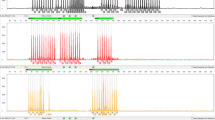Abstract
The InnoTyper 21® Human Identification kit consists of amelogenin and 20 bi-allelic Alus, retrotransposon markers existing abundantly in human genome. The InnoTyper 21® kit produces shorter amplicons (60–125 bp) than conventional short tandem repeat (STR) genotyping kit, then it is effective on the analysis of challengeable forensic samples including insufficient or highly degraded DNAs. Also, as the genotyping with InnoTyper21® kit is compatible with PCR and capillary electrophoresis, it is easy to incorporate into the workflow in forensic laboratories. In the internal validation of InnoTyper21® kit on sensitivity, degradation, and mixture studies for the evaluation in this study, we acquired full profiles on analyzing small concentration DNA (as low as 25 pg) and highly degraded DNA (up to 105 degradation index value). Through the Korean population study, forensic statistical parameters were investigated and a specific variant of T insertion in NBC51 was confirmed in six samples. Comparison of Korean population with five populations or 1000 Genomes Project data show Korean specific substructure. It is expected that the InnoTyper 21® kit will be used into the actual forensic cases, utilizing the population study investigated through this research.



Similar content being viewed by others
References
Batzer MA, Deininger PL (2002) Alu repeats and human genomic diversity. Nat Rev Genet 3:370–379
Terreros MC, Alfonso-Sánchez MA, Novick GE, Luis JR, Lacau H, Lowery RK, Regueiro M, Herrera RJ (2009) Insights on human evolution: an analysis of Alu insertion polymorphisms. J Hum Genet 54:603–611
Cordaux R, Srikanta D, Lee J, Stoneking M, Batzer MA (2007) In search of polymorphic Alu insertions with restricted geographic distributions. Genomics 90:154–158
Mamedov IZ, Shagina IA, Kurnikova MA, Novozhilov SN, Shagin DA, Lebedev YB (2010) A new set of markers for human identification based on 32 polymorphic Alu insertions. Eur J Hum Genet 18:808–814
Sinha S, Murphy G, Brown H, Green A’, Montgomery A, Carrol M, Tabak J (2015) Retrotransposable elements: novel and sensitive DNA markers and their application in human identity. Forensic Sci Int Genet Suppl Ser 5:e627–e629
Brown H, Thompson R, Murphy G, Peters D, la Rue B, King J, Montgomery AH, Carroll M, Baus J, Sinha S, Wendt FR, Song B, Chakraborty R, Budowle B, Sinha SK (2017) Development and validation of a novel multiplexed DNA analysis system, InnoTyper® 21. Forensic Sci Int Genet 29:80–99
Westen AA, Kraaijenbrink T, Robles De Medina EA et al (2014) Comparing six commercial autosomal STR kits in a large Dutch population sample. Forensic Sci Int Genet 10:55–63
Ludeman MJ, Zhong C, Mulero JJ, Lagacé RE, Hennessy LK, Short ML, Wang DY (2018) Developmental validation of GlobalFilerTM PCR amplification kit: a 6-dye multiplex assay designed for amplification of casework samples. Int J Legal Med 132:1555–1573
Grisedale KS, Murphy GM, Brown H, Wilson MR, Sinha SK (2018) Successful nuclear DNA profiling of rootless hair shafts: a novel approach. Int J Legal Med 132:107–115
Martins C, Ferreira PM, Carvalho R, Costa SC, Farinha C, Azevedo L, Amorim A, Oliveira M (2019) Evaluation of InnoQuant ® HY and InnoTyper ® 21 kits in the DNA analysis of rootless hair samples. Forensic Sci Int Genet 39:61–65
Holland MM, Fisher DL, Mitchell LG et al (1993) Mitochondrial DNA sequence analysis of human skeletal remains: identification of remains from the Vietnam War. J Forensic Sci 38:13439
Budowle B, Wilson MR, DiZinno JA et al (1999) Mitochondrial DNA regions HVI and HVII population data. Forensic Sci Int 103:23–35
Ristow PG, Barnes N, Murphy GP, Brown H, Cloete KW, D’Amato ME (2017) Evaluation of the InnoTyper® 21 genotyping kit in multi-ethnic populations. Forensic Sci Int Genet 30:43–50
Moura-Neto RS, Mello ICT, Silva R, Maette APC, Bottino CG, Woerner A, King J, Wendt F, Budowle B (2018) Evaluation of InnoTyper® 21 in a sample of Rio de Janeiro population as an alternative forensic panel. Int J Legal Med 132:149–151
Martins C, Ferreira PM, Carvalho R, Costa SC, Farinha C, Azevedo L, Amorim A, Oliveira M (2018) Internal validation of two new retrotransposons-based kits (InnoQuant® HY and InnoTyper® 21) at a forensic lab. Forensic Sci Int 283:1–8
Larue BL, Sinha SK, Montgomery AH et al (2012) INNULs: a novel design amplification strategy for retrotransposable elements for studying population variation. Hum Hered 74:27–35
Sudmant PH, Rausch T, Gardner EJ et al (2015) An integrated map of structural variation in 2,504 human genomes. Nature 526:75–81
Stewart C, Kural D, Strömberg MP, Walker JA, Konkel MK, Stütz AM, Urban AE, Grubert F, Lam HYK, Lee WP, Busby M, Indap AR, Garrison E, Huff C, Xing J, Snyder MP, Jorde LB, Batzer MA, Korbel JO, Marth GT, 1000 Genomes Project (2011) A comprehensive map of mobile element insertion polymorphisms in humans. PLoS Genet 7(8):e1002236
Acknowledgment
This study was provided with bioresources from the National Biobank of Korea, the Centers for Disease Control and Prevention, Republic of Korea.
Funding
This study was supported by the National Forensic Service (NFS2020DNA03).
Author information
Authors and Affiliations
Corresponding author
Ethics declarations
Conflict of interest
The authors declare that they have no conflict of interest.
Additional information
Publisher’s note
Springer Nature remains neutral with regard to jurisdictional claims in published maps and institutional affiliations.
Rights and permissions
About this article
Cite this article
Kim, G.H., Kwon, S.Y., Lee, SY. et al. Evaluation of the InnoTyper21® system for the applications into trace and degraded DNA in the Korean population. Int J Legal Med 134, 2053–2059 (2020). https://doi.org/10.1007/s00414-020-02429-3
Received:
Accepted:
Published:
Issue Date:
DOI: https://doi.org/10.1007/s00414-020-02429-3




